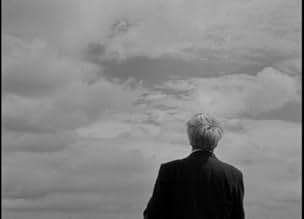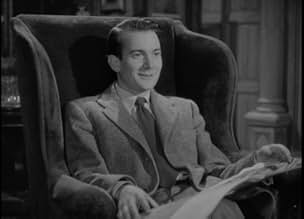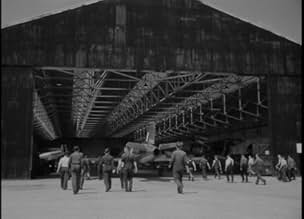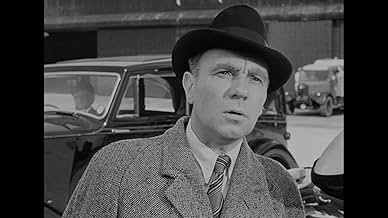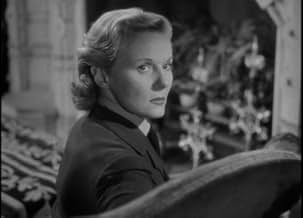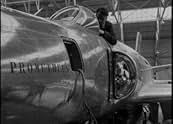NOTE IMDb
6,7/10
2,5 k
MA NOTE
Ajouter une intrigue dans votre langueFictionalized story of British aerospace engineers solving the problem of supersonic flight.Fictionalized story of British aerospace engineers solving the problem of supersonic flight.Fictionalized story of British aerospace engineers solving the problem of supersonic flight.
- Récompensé par 1 Oscar
- 9 victoires et 5 nominations au total
Rodney Goodall
- Little Boy
- (non crédité)
Donald Harron
- ATA Officer
- (non crédité)
Vincent Holman
- Factor
- (non crédité)
Jolyon Jackley
- Susan's Baby
- (non crédité)
Douglas Muir
- Controller
- (non crédité)
Leslie Phillips
- Controller
- (non crédité)
Anthony Snell
- Peter Makepeace
- (non crédité)
Sally-Jane Spencer
- Daughter of Philip
- (non crédité)
Robert Brooks Turner
- Test Bed Operator
- (non crédité)
Avis à la une
The movie really does capture a sense of time and the tremendous bravery of those involved in the breaking of the sound barrier.The cast is excellent and as usual Denholm Elliot steals every scene he's involved in. I feel this film is under-rated and is typical of much of the good work of British Cinema in the 50's
This black and white early 50s movie shows crusty Britain at its stiff upper lip best. It is the story of mans obsession with speed, and a ruthless plane makers ambition to succeed in building a supersonic jet. Richardson plays the tycoon whose dream kills his son and son-in-law, but who finally sees the error of his ways and whose daughter returns to the cold family home with his grandson.
The film is also a vehicle to show the world Britain's proud lead in jet technology. There is a classic sequence in the film where the happy daughter and son-in-law deliver a De Havilland Vampire jet fighter to Egypt. They set off at breakfast time in England and hurtle over the English Channel, the Alps, Ancient Greece and the Pyramids before arriving in at the airfield. Of course we take this for granted now, but 47 years ago this was unheard of. The director contrasts the old ruins and remains of our ancient ancestors with the marvel of the modern age: the jet plane.
The film also introduced THE marvel of the early fifties, the De Havilland Comet jet liner. This beautiful but flawed machine was in service SIX years before any other jet liner and for a while, the world rushed to De Havillands, and Britains door. For two years the worldwide fleet gave the travelling of the future.
In every other way this is an eccentrically English film with creaky old houses, cottages with roses around the door and eccentric engineers. Shout in glorious black and white it conveys a sense of wonder and optimism in the future, whilst being thoroughly old fashioned
The film is also a vehicle to show the world Britain's proud lead in jet technology. There is a classic sequence in the film where the happy daughter and son-in-law deliver a De Havilland Vampire jet fighter to Egypt. They set off at breakfast time in England and hurtle over the English Channel, the Alps, Ancient Greece and the Pyramids before arriving in at the airfield. Of course we take this for granted now, but 47 years ago this was unheard of. The director contrasts the old ruins and remains of our ancient ancestors with the marvel of the modern age: the jet plane.
The film also introduced THE marvel of the early fifties, the De Havilland Comet jet liner. This beautiful but flawed machine was in service SIX years before any other jet liner and for a while, the world rushed to De Havillands, and Britains door. For two years the worldwide fleet gave the travelling of the future.
In every other way this is an eccentrically English film with creaky old houses, cottages with roses around the door and eccentric engineers. Shout in glorious black and white it conveys a sense of wonder and optimism in the future, whilst being thoroughly old fashioned
I saw "The Sound Barrier" in 1952 and it had a great impact on this young moviegoer. The opening sequence on an abandoned air base and the theme music have stayed with me for 50 years. Apparently this film is not available in the USA at present, but I hope it will return to our shores. The technical side of the movie may be less relevant now, when men and women fly far beyond the speed of sound and far beyond the earth's atmosphere. But the story of the characters is what I remember best: the closeness of the small band of test pilots and their loved ones, how they are inspired by the promise of supersonic flight, and how they react when things go wrong.
7sol-
British aviation enthusiasts seek to break the sound barrier by dangerously pushing their jets beyond their limits in this solidly crafted drama starring Ralph Richardson. The film has copped a lot of flak over the years for its historical inaccuracies (the Americans were actually the first to break the sound barrier with very different techniques), however, 'The Sound Barrier' works well as a character drama as long as one takes all the pseudoscience on hand with a pinch of salt. The movie is rather slow to warm up, focusing on a formulaic courtship between Richardson's daughter and an up and coming pilot, however, as soon as Richardson enters the scene, it becomes an experience that rarely lets up. It is quite a sight to see Richardson's boyish enthusiasm for the task at hand, waxing poetic about a "whole new world ... in the grasp of man", demonstrating how aerial flight works during dinner and proclaiming that "it's just got to be done". His character also comes with shades of ambiguity; is he at all guilt-ridden over the deaths of those trying to complete the quest or does he see the deaths as acceptable in the name of human progress? Richardson does very well adding such shades to his character and while none of the supporting players come close to equaling him, he is enough alone to carry the film, or at least when on-screen. The film is also blessed by some great spinning shots within mysterious clouds and as one might expect from a film with such a title, the Oscar winning sound mixing here is highly effective.
By many standards, David Lean's production of the film he directed in 1952, "The Sound Barrier" is both unusual and I suggest rewarding. The screenplay by Terence Rattigan I found to be riveting throughout. This I judge stems from the fact that its subject is men of vision, and what they do to about their greed for something unnameable, necessary and sometimes deadly. The author in the film is at pains not to paint such men as glory hunters, nor seekers after excitement alone; in one scene, the central character talks about the fliers of the past, and then suggests the men of the future will need vision even more than flying skills to conquer what awaits us--and the answer to what that is is given as "the stars"--called the final frontier in this film in all but name. There are three fliers we meet in the film at a fictitious industrial empire called Ridgefield. The boss's son who hasn't got what a flier needs, Tony, who marries his daughter and reaches his limit because he lacks the necessary genius, and Philip, who has "the right stuff". What I find extraordinary about this very well-directed cinematic tale is that it is always about the people and the joy and danger of flight at the same time, without the focus ever losing sight of the people. The music for this film was supplied by Malcolm Arnold, and it is extraordinary almost everywhere but I find never intrusive. One sequence involves one of the three pilots taking his new wife for a swift flight to Cairo from England; the scene accomplishes many things at once. She learns because of her journey, what some men see in the serenity of the sky, and even its danger; it introduces us to the third pilot and his wife; and we are given a sense of the camaraderie of the men who flew in those days; another such moment occurs when the French ace Geoffrey de Havilland is killed trying to break the sound barrier ahead of all others. Jack Hildyard and several others supplied the cinematography and aerial scenes; Elizabeth Hemminges did a fine subdued job on the costumes; Vincent Korda is credited with the Art Department's superb work while Muir Matheson is acknowledged as music director. Among the smallish cast, the pilots are all beautifully played. bright Nigel Patrick is likable ace Tony, young Denholm Elliot stands out as the boss's son, and John Justin is just right as the third of the trio, Philip. Joseph Tomelty is admirable as Will Sparks, the designer tormented by his own part in causing test pilots to risk their lives; Ann Todd is good as the tormented Susan, wife to Tony and daughter of the boss of Ridgefield. Dinah Sheridan is also lovely as Philip's brave wife; but it is Ralph Richardson's powerful realization of John Ridgefield, former pilot, towering presence and inspiring and dangerous leader of men who along with Justin gives the film its unusual dimension of mind and purpose. One may quarrel with the motivations attributed to Richardson in the last scenes; but he has been so alone in his vision and at such a cost, he may be forgiven for asking at last to be understood. The ending I find to be most satisfying, the film's climax tremendously moving. This is a great film, which has never been appreciated as it should have been. It is B/W film-making at its dramatic best for my money. Its science may not be perfect, but its depiction of human merit and what happens when that quality is lacking in a man is powerful indeed. Not to be missed.
Le saviez-vous
- AnecdotesThe flying sequences under the direction of Anthony Squire, were based at the Vickers aerodrome at Chilbolton near Nether Wallop in Hampshire. Squire managed to secure one of the last airworthy Avro Lancaster bombers for the task. The cameramen were positioned in the front and rear turrets while Squire conducted proceedings from the central astrodome. The Lancaster was replaced by a Vickers Valetta after all the crew except Squire fell asleep due to an oxygen supply failure. Luckily as he recalled, "They all woke up on the way down, like people in a fairy wood, but I didn't bother with the Lancaster again."
- GaffesAfter he and his wife alight from a Comet airliner, Garthwaite is seen reading that evening's newspaper, dated Saturday, 28 September 1946. The Comet didn't make its maiden flight until July 1949 and didn't enter service until 1952.
- Citations
Susan Garthwaite: [regarding an image of the surface of the moon, displayed via JR's telescope] What's that?
John Ridgefield: It's the moon.
Susan Garthwaite: I never knew it could look so unfriendly.
John Ridgefield: It's an unfriendly universe.
Susan Garthwaite: Do you believe that?
John Ridgefield: Unfriendly only because it's unconscious of our existence.
- Crédits fousIn the opening credits, immediately after the human actors, are listed four British aircraft: The de Havilland COMET The Vickers-Supermarine ATTACKER The de Havilland VAMPIRE 113 The Vickers-Supermarine SWIFT Rolls-Royce 'Avon' Engine
- ConnexionsFeatured in Jet! When Britain Ruled the Skies: Military Marvels (2012)
- Bandes originalesWith Sword and Lance
(uncredited)
Music by Hermann Starke
Meilleurs choix
Connectez-vous pour évaluer et suivre la liste de favoris afin de recevoir des recommandations personnalisées
- How long is The Sound Barrier?Alimenté par Alexa
Détails
- Date de sortie
- Pays d’origine
- Langue
- Aussi connu sous le nom de
- Breaking the Sound Barrier
- Lieux de tournage
- Chilbolton Aerodrome, Nether Wallop, Hampshire, Angleterre, Royaume-Uni(flying sequences)
- Sociétés de production
- Voir plus de crédits d'entreprise sur IMDbPro
Box-office
- Budget
- 250 000 £GB (estimé)
- Durée
- 1h 58min(118 min)
- Couleur
- Rapport de forme
- 1.37 : 1
Contribuer à cette page
Suggérer une modification ou ajouter du contenu manquant


